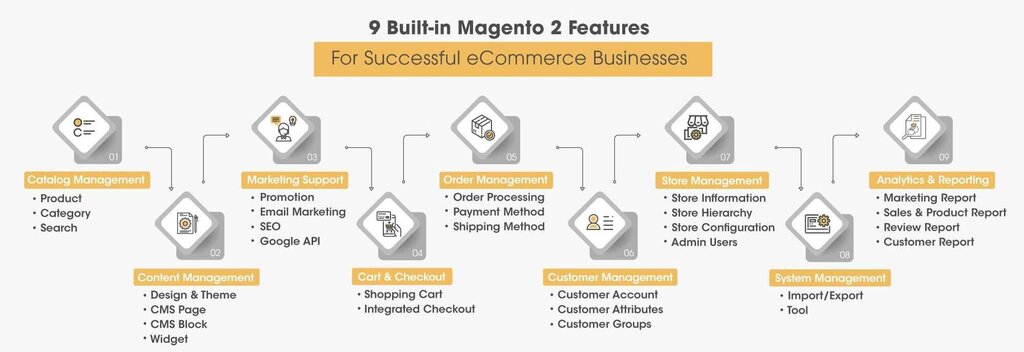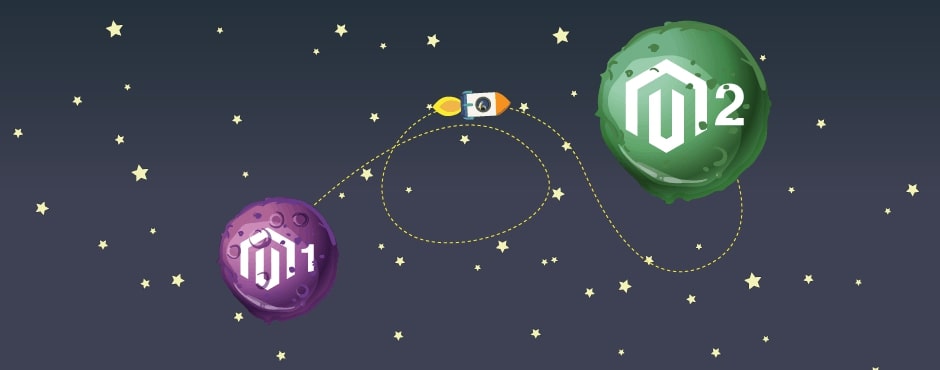
Magento 2 is an ecommerce software built on open-source technology. The first version was launched in 2008. However, the second version is later on launched in 2015 with newer features. This latest version utilizes high coding standards which improves the performance & security. It is much faster & feature-rich than M1 and supports PHP 7. In this article, you will get a complete Magento 2 tutorial.
Magento 2 Features

The M2 new version provides great features that improves your user’s shopping experience. This is why many big businesses trust this platform when it comes to building an online store.
So, what online store features you get with Magento 2 features?
-
Faster page loading
Your new version provides a fast loading catalog and check out pages. This in turn provides the best shopping experience to your customers. Ultimately, you can smoothly improve your scalability.
-
Secure payment methods
This new version facilitates safest payment gateways for your customers. You can safeguard the payment transaction against hackers.
-
Latest technologies
In M2, you get the latest Magento 2 features & functionalities. This feature-rich platform is great for your online store. Moreover, you can easily upgrade the latest version and store maintenance is easy.
Is it mandatory to migrate from Magento 1 to Magento 2?

Recently, Magento has stopped supporting its first version launched in 2008. In other words, you will not be able to upgrade the first version. So, you must migrate from M1 to M2 to stay up-to-date with a feature-rich platform. Further, in this Magento 2 tutorial, we will also learn about migration.
So, you will face these issues if you do not shift from M1 to M2.
Restriction on Payment Gateway options
It is recommended that you move to M2 sooner. If not upgraded, you might face security issues & loss of PCI Compliant. As a result of which, you may lose the support of various payment gateway providers. Ultimately, it will place a cap on credit card payment methods. So, there will be fewer credit card payment options for your ecommerce customers.
Reduced website performance
As M1 will get obsolete, many extensions that support M1 will also get outdated. So, if any extension suddenly stops working, then your website will also stop functioning correctly.
Lack of developer support
With latest updates, many M1 developers will put their energies on M2 store set ups. So, if you still do not upgrade to M2, you can face support problems from developers end. This is why you should upgrade to M2 by following steps given in this Magento 2 tutorial.
How to migrate M1 to M2?
The migration process should be carried out smoothly. Otherwise, you might face data loss issues and corrupted online store functionality.
So, you can ensure below things to safeguard yourself from major losses.
- Get a backup of your M1 store with every database and files.
- Use the M1 clone to execute the migration process. You should never use the live online store to initiate migration.
- Re-check what’s on your store. You can delete irrelevant themes & extensions to bring ease in the whole process. Deleting themes & plugins that do not support M2 is a good idea.
- Consider migrating databases to Magento 2 from the cloned version.
- You can delete cache, logs, and any other useless & obsolete data from the databases.
- In the end, you are required to install M2 copy on the same hosting server where your M1 resides.
Make sure that you do miss on any step stated above in this Magento 2 tutorial. Once done, the actual migration procedure begins!
There are 4 stages:
- Theme migration
- Extension migration
- Customization migration
- Data migration
Further, I have explained every step in a detailed manner.
-
Theme migration
You cannot directly migrate the M1 theme to M2. So, you need to download a theme from Magento Marketplace. Otherwise, you can also develop a customized theme.
2. Extension migration
You cannot move themes from M1 to M2. Same way, one cannot migrate M1 extensions to M2. So, Magento 2 tutorial suggests to download the relevant extensions from the official store.
3. Customization migration
Your store might be running on custom code. So, you should ensure safety while migrating the custom codes to newer versions.
4. Data migration
Your store contains customer, orders, products data and store configurations. You cannot bear losing this data at any costs. So, you can transfer the valuable data using Magento 2 Data Migration Tool.
This is the ultimate process to shift your online store from M1 to M2. I hope this Magento 2 tutorial has helped you.
Also Read, A Beginners Guide to What is WordPress WooCommerce Plugin
A Beginner’s Detailed Guide to What is WordPress
Important links:
Magento Marketplace – https://marketplace.magento.com/
